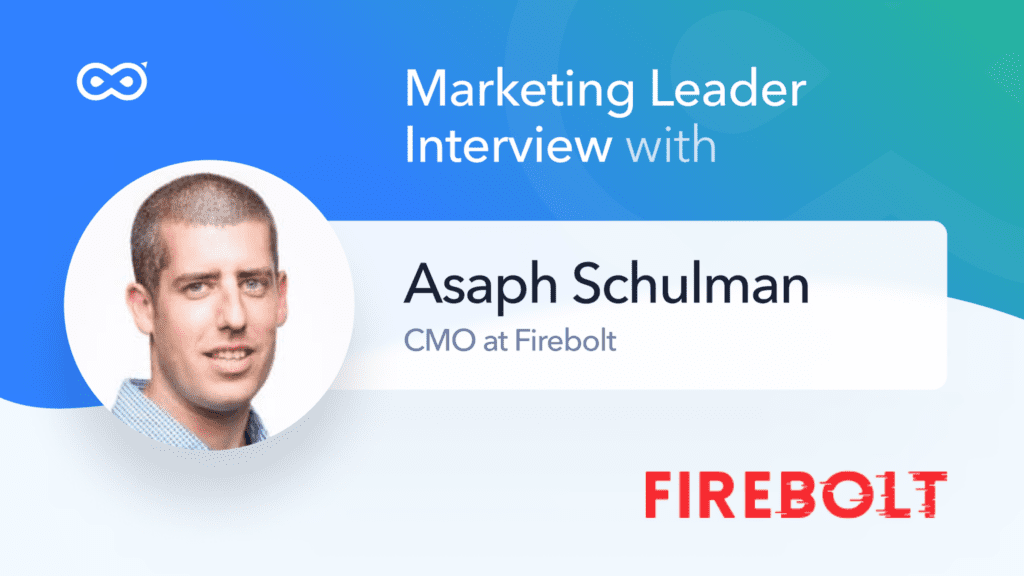We’re back with another episode of Q&A with Marketing Leaders, a series we’ve designed to provide you with the latest tips and ideas on B2B marketing. By learning from the best B2B leaders in the industry, you can improve revenue marketing practices in your company.
In this edition, we spoke with Asaph Schulman, CMO of Firebolt.
Asaph Schulman is an entrepreneur who has led a number of start-ups in Israel and Australia. As the VP of Marketing for Checkmarx, he drove 85x revenue growth and a 20x growth in team size. After Checkmarx, he took over as the CEO of Coinmama before moving to the role of CMO at Firebolt in 2019. Firebolt is a Cloud data warehousing and analytics company that provides high-speed data analytics in the terabyte to petabyte range.
With his wide-ranging experience in driving marketing strategy for a bunch of organizations, we are sure to get some great insights today. Let’s jump right in.
What are the marketing tools that you can’t live without?
Well, I’m actually not a big “tools” person. The tool that I can’t live without is HubSpot by far.
Fun fact: I was HubSpot’s first user in Israel back in 2011. I saw this platform grow to the beast that it is today, and we use it religiously on so many fronts.
We previously used both of Hubspot’s components—the marketing automation solution as well as the CRM. Now, we’ve moved to Salesforce for other reasons. As long as the user base isn’t huge, CRM is also nice. Obviously, we use automation, lead-capturing, nurturing, the live chat component, reporting and analytics scoring, and the scheduling tool that they have. There are so many goodies there. I really like it.
What is the most common marketing mistake that you see?
I see many. Let me just list them out:
- I think the most common one—which is really crazy—is that marketers don’t speak to sales.
There’s a misalignment with sales. It has gotten to the point where I hear salespeople saying, “Yeah, we’re not working with the marketing team. We’ve got our own marketing.”
Salespeople are getting freelancers to do marketing for them! It’s crazy.
I think the first and most important thing, especially if you’re a revenue marketer, or you consider yourself to be one, is to have the closest possible alignment with sales.
You need to be speaking regularly with sales. You need to set the objectives together and have a very clear handshake of what marketing needs to deliver and what sales need to do with that. I think this is really critical to make sure that everybody’s aiming in the same direction.
- The second thing that I see is that marketing often focuses on things that don’t really matter.
Leads and even MQLs are nice, but they’re mainly leading indicators that can show if you’re on track to the real goal of revenue.
I don’t care about how many leads we create. I care about the metric that we decided we need to optimize for, which also changes. It’s an evolution.
- Another common mistake I see is that everybody’s trying to “take over the world,”geographically speaking.
I think this is a huge mistake—especially if you’re a start-up—if you’ve got a limited budget. You want to create some motion, some sort of flywheel effect. To do this when you have one prospect in Germany, one in the US, one in Japan, and so on, is a lot more difficult than having all of them nicely situated in, say, San Francisco.
Focusing geographically on a very small area while specifically going after your ideal customer profile and not trying to sell it to everyone everywhere—I think this is very important.
I admit I made this mistake in my early days as well. Don’t try to conquer the world immediately. Do it one geographic location at a time and one person at a time, and you’ll see this snowball effect happening much faster.
That’s interesting. Everyone is saying, “Don’t market to everyone. Find your niche.” But you’re discussing the geographic element. Just focus on specific geographic locations so that you have this effect of people talking about you, of people starting to know your brand.
Obviously, the world is a lot flatter now than it used to be, but even today, there are so many groups, there are meet-ups, there are people that simply know each other—they work together, or they’re colleagues, or they’ve got friends—so these tend to be closely related to geography. You don’t have to choose just a single location, but you can have pockets of demand that you want to create around, say, San Francisco, New York, UK, whatever. Don’t spread yourself too thin.
You’ve mentioned that marketers focus on metrics that don’t really matter. What metrics do you currently own and optimize for in Firebolt?
The metric we currently optimize for is SQLs.
Now, the disclaimer is that every company has a very different definition of these metrics. I see many people asking, for example, what’s your conversion between lead to MQL? I can tell you what the rate is. It may not be relevant to you, so be very suspicious and look at the fine details when you’re trying to benchmark yourself against others.
We are actually optimizing for SQLs, which, in our world, means customer prospects that meet our very, very detailed customer profile. They need to be A, B, C, D, and E, plus they need to attend a meeting. Finally, sales determine whether it’s an SQL or not. After an ideal customer profile attends a meeting and sales prove this is a good fit, only then do we mark them as an SQL.
So you define SQLs based on specific parameters that are aligned with your ICP, as well as an intent parameter of attending a meeting, as well as another parameter of Sales manually approving the lead’s fit.
Correct. This is an evolution as well. I’m sure this will continue to change. We have revenue targets, so we look at that as well, but this is the number that the marketing team rallies around.
In terms of revenue targets, do you have a shared goal with sales or a marketing-generated revenue target?
We have a shared goal because marketing currently drives 100% of that goal. At this point, marketing is considered the driver of all revenue. As we grow, there will be more channels where marketing will play a role in assisting or influencing but not necessarily generating.
Do you have an outbound process?
We do. It’s fairly new, and that also sits within marketing.
Interesting. A lot of people ask whether BDRs should sit within marketing or within sales.
Research shows that in two-thirds of the cases, the company’s BDRs sit within sales, and in one-third of the cases, BDRs sit within marketing. I think it makes more sense to have BDRs within marketing, but it really depends. It depends on who’s running marketing, who’s running sales, and what their capacity is. It can also change in the same company in the future. If the deliverable from marketing to sales is qualified meetings, then BDRs are just another channel.
How do you manage the marketing planning process?
We follow a broad planning process at the beginning of the year. But the reality is that we live in such a dynamic environment that it’s very difficult to stick to whatever we plan. Things keep changing all the time. You decide to recruit a new AE in a new territory. Then, all of a sudden, things shift. I’ve yet to see a plan that actually happened as we envisioned.
You need to try things and check. If it works, double down on that; if it doesn’t, just kill it. No issues.
Firebolt recently launched a very successful creative campaign, specifically, some great videos. How much are you relying on organic amplification? Or are you investing heavily in paid campaigns to get the message across?
Most companies spend a lot of time on getting the creative right, which is fine, but you can shout as much as you want in the middle of the forest. If no one hears, then what’s the point?
I think you need to spend time thinking about distribution rather than depending only on the “wow” factor of a creative campaign. For us, we rely a lot on organic social, but we do use paid distribution to get that flywheel effect happening as well. So it’s both.
How do you evaluate the success of these “brand” campaigns?
It’s very tough to actually attribute these types of “brand” creative campaigns. First of all, I look at qualitative inputs. We’re bombarded with positive feedback. Feedback from our target audience. So that’s one thing to consider.
The other thing is, you perceive the impact on the brand. Brand awareness rises. Brand searches go up.
When it comes to actual attribution, I think attribution is important, but it has limits.
For example, recently we’re seeing a rise in closed Slack communities, WhatsApp communities, and other closed gardens. Here, you just can’t measure the engagement. If someone is exposed to your creative and shares it there, then people will come to your site. But you just don’t know where they came from and how it happened.
Or, you hear people saying, “I got it from a colleague,” “I got it from a friend,” “I got it from my grandma,” and so on. There’s a limit to how much you can do to understand the attribution of the person who referred your visitor. You just need to accept the fact that you don’t know everything.
And understand that creative is the final frontier, where having deep pockets does not necessarily mean being more creative. This is especially true if you’re a start-up, and it’s definitely the case for us. We’re competing with giants.
We won’t compete with the big cloud providers and pay hundreds of dollars per click on adverts for the obvious keywords. But we’ll do something creative that’s also low on budget. One of our actors is our solution architect. We thought, “who could be the best actor for that?”, and we said: Matan.
So we just went to Matan and said, “Do you mind doing poses, spending half an hour with us?” This mindset is really useful if you’re in marketing and try to use whatever you have. Fiverr is great for doing a lot of the editing—super useful. So even with a very low budget, you can come up with some great creatives. You just need to come up with crazy ideas and not be afraid to just go for it.



